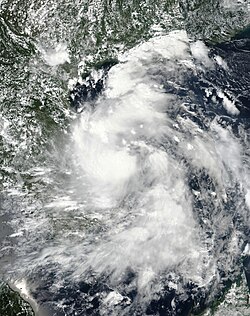 Tropical Storm Dianmu at peak intensity just before landfall Vietnam on September 23. | |
| Meteorological history | |
|---|---|
| Formed | September 22,2021 |
| Dissipated | September 26,2021 |
| Tropical storm | |
| 10-minute sustained (JMA) | |
| Highest winds | 65 km/h (40 mph) |
| Lowest pressure | 1000 hPa (mbar);29.53 inHg |
| Tropical storm | |
| 1-minute sustained (SSHWS/JTWC) | |
| Highest winds | 65 km/h (40 mph) |
| Lowest pressure | 1001 hPa (mbar);29.56 inHg |
| Overall effects | |
| Casualties | 8 dead,5 missing |
| Damage | $16.3 million (2021 USD) |
| Areas affected | Vietnam,Laos,Thailand |
| IBTrACS | |
Part of the 2021 Pacific typhoon season | |
Tropical Storm Dianmu was a weak tropical cyclone that caused considerable damage over parts of Mainland Southeast Asia during late-September 2021. The fifteenth named storm of the 2021 Pacific typhoon season,Dianmu originated from an area of low-pressure situated in the South China Sea on September 21. Being first monitored by the Joint Typhoon Warning Center,the system rapidly consolidated to a tropical depression on September 22 as it continued to approach Vietnam before strengthening further to a weak tropical storm,with the Japan Meteorological Agency naming it as "Dianmu". Little intensification occurred before it made landfall on the country with winds of 35 knots (65 km/h;40 mph). It then rapidly weakened over land and dissipated on September 24 as a tropical cyclone.
Contents
Heavy rains resulted in severe flooding in Vietnam and Thailand,as well as affecting Laos during its lifespan. Many livestock and agricultural lands were also affected,along with over 300,000 people. 8 people were killed and 5 were missing due to Dianmu's onslaught. A short-lived storm,after it crossed into the Mainland Southeast Asia,its remnants emerged into the Bay of Bengal and affected the West Bengal.

